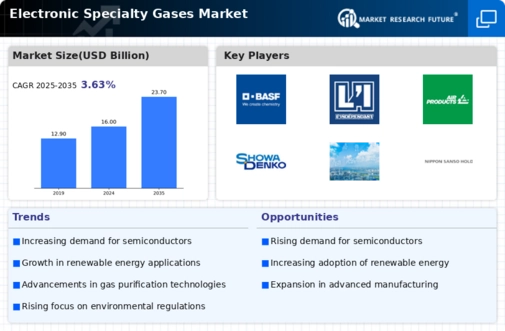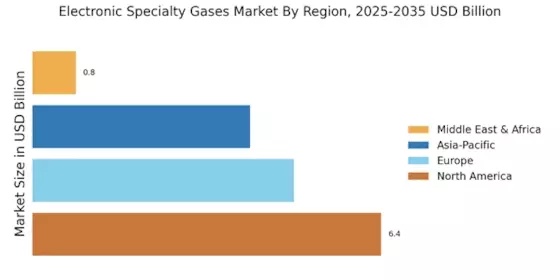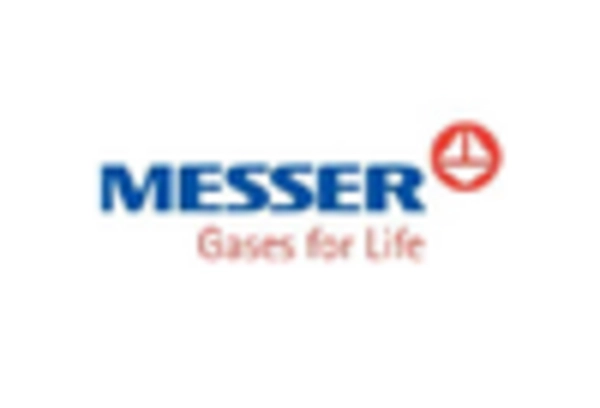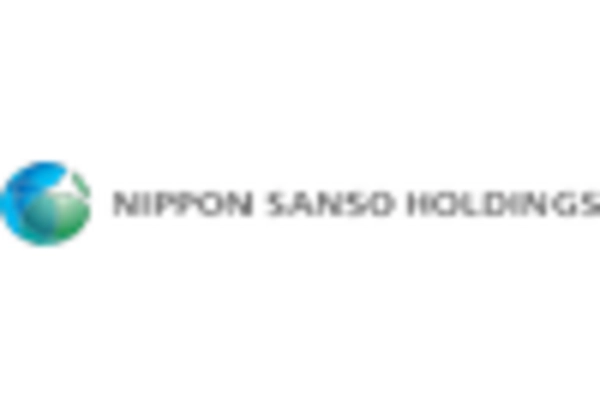Growth in Renewable Energy Technologies
The Electronic Specialty Gases Market is poised for growth due to the increasing adoption of renewable energy technologies. As solar and wind energy systems become more prevalent, the demand for specialty gases used in photovoltaic cell production and energy storage systems is rising. For instance, gases like hydrogen and argon are crucial in the manufacturing of solar panels. The renewable energy sector is expected to grow at a compound annual growth rate (CAGR) of over 20% in the coming years, which will likely drive the consumption of electronic specialty gases. This trend indicates a shift towards sustainable energy solutions, thereby enhancing the relevance of the Electronic Specialty Gases Market in supporting these technologies.
Regulatory Compliance and Safety Standards
The Electronic Specialty Gases Market is also shaped by stringent regulatory compliance and safety standards. Governments and regulatory bodies are increasingly enforcing regulations regarding the handling and use of specialty gases to ensure environmental safety and worker protection. This has led to a heightened focus on the production of high-purity gases that meet these standards. In 2025, the market for electronic specialty gases is projected to be influenced by these regulations, as companies invest in technologies that comply with safety protocols. This trend not only enhances the credibility of the Electronic Specialty Gases Market but also drives innovation in gas production and handling processes.
Rising Demand for Semiconductor Manufacturing
The Electronic Specialty Gases Market is experiencing a surge in demand driven by the semiconductor manufacturing sector. As technology advances, the need for high-purity gases such as nitrogen trifluoride and silane is increasing. In 2025, the semiconductor industry is projected to reach a market value of approximately 600 billion USD, which directly correlates with the rising consumption of electronic specialty gases. These gases are essential for processes like etching and deposition, which are critical in chip production. The growth of the Internet of Things (IoT) and artificial intelligence (AI) applications further fuels this demand, as more sophisticated chips are required. Consequently, the Electronic Specialty Gases Market is likely to expand significantly to meet the needs of this evolving sector.
Emergence of Advanced Manufacturing Techniques
The Electronic Specialty Gases Market is witnessing a transformation due to the emergence of advanced manufacturing techniques such as additive manufacturing and 3D printing. These technologies require specific types of specialty gases to optimize production processes. For example, gases like carbon dioxide and nitrogen are essential in additive manufacturing to ensure quality and precision. The market for 3D printing is anticipated to grow at a CAGR of over 25% in the next few years, which will likely increase the demand for electronic specialty gases. As industries adopt these innovative manufacturing methods, the Electronic Specialty Gases Market is expected to evolve, adapting to the unique requirements of these advanced processes.
Advancements in Electronics and Consumer Devices
The Electronic Specialty Gases Market is significantly influenced by advancements in electronics and consumer devices. The proliferation of smart devices, including smartphones, tablets, and wearables, necessitates the use of high-purity gases in their manufacturing processes. In 2025, the consumer electronics market is expected to exceed 1 trillion USD, which will likely increase the demand for electronic specialty gases. These gases are integral to processes such as chemical vapor deposition and plasma etching, which are essential for producing miniaturized components. As manufacturers strive for higher efficiency and performance, the Electronic Specialty Gases Market is expected to adapt and grow in response to these technological advancements.


















Leave a Comment